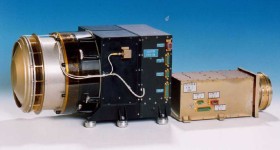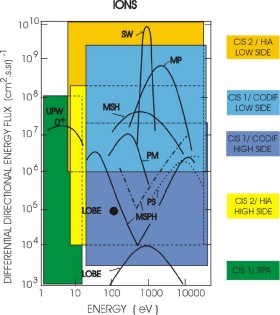
|
Cluster/CIS
|
 |

|
Cluster/CIS
|
 |
| Science objectives | |
| CIS instrument description | |
|
MPS contribution |
|
| Project status | |
| Related links | |
| Cluster/CIS publications by MPS members |
The prime scientific objective of the ![]() CIS (Cluster Ion Spectrometry) instrument is the study of the dynamics of magnetized plasma structures in and in the vicinity of the Earth's magnetosphere. The four Cluster spacecraft with relative separation distances that can be adjusted to spatial scales of the structures (a few hundred kilometers to several thousand kilometers) give for the first time the possibility to distinguish between spatial and temporal variations.
CIS (Cluster Ion Spectrometry) instrument is the study of the dynamics of magnetized plasma structures in and in the vicinity of the Earth's magnetosphere. The four Cluster spacecraft with relative separation distances that can be adjusted to spatial scales of the structures (a few hundred kilometers to several thousand kilometers) give for the first time the possibility to distinguish between spatial and temporal variations.
The CIS instrument has been designed to provide substantial contributions to:
The CIS instrument is an international collaboration lead by the ![]() Centre d'Etude Spatiale des Rayonnements (CESR) in
Toulouse (Principle Investigator Prof H. Rème). The CIS instrument is a package of two sensors to cover a large energy range
and to analyze the composition and dynamics of the magnetospheric ions. The sensors named
Centre d'Etude Spatiale des Rayonnements (CESR) in
Toulouse (Principle Investigator Prof H. Rème). The CIS instrument is a package of two sensors to cover a large energy range
and to analyze the composition and dynamics of the magnetospheric ions. The sensors named
 The CODIF instrument (left) is high resolution spectrometer that measures three-dimensional distribution functions of the principal ions in the magnetosphere (H+, He+, He++, O+). This instrument combines the selection of incoming ions according to their energy per charge by electrostatic deflection in a hemispherical analyzer with a subsequent time-of-flight analysis after a post acceleration of the incoming ions. The CODIF sensor includes also a Retarding Potential Analyzer (RPA) for the energy range 0 - 30 eV. The HIA instrument (right) is in principle like the CODIF instrument, but without the time-of-flight part, therefore it does not provide composition measurements. The HIA sensor is especially suited to measure the high particle flux of the solar wind (SW). There is a sophisticated data processing system (DPS) (middle) to control and to process the data of the sensors. This unit allows extensive onboard data processing. The main features and measured parameters of the CIS instrument are shown in the table below.
The CODIF instrument (left) is high resolution spectrometer that measures three-dimensional distribution functions of the principal ions in the magnetosphere (H+, He+, He++, O+). This instrument combines the selection of incoming ions according to their energy per charge by electrostatic deflection in a hemispherical analyzer with a subsequent time-of-flight analysis after a post acceleration of the incoming ions. The CODIF sensor includes also a Retarding Potential Analyzer (RPA) for the energy range 0 - 30 eV. The HIA instrument (right) is in principle like the CODIF instrument, but without the time-of-flight part, therefore it does not provide composition measurements. The HIA sensor is especially suited to measure the high particle flux of the solar wind (SW). There is a sophisticated data processing system (DPS) (middle) to control and to process the data of the sensors. This unit allows extensive onboard data processing. The main features and measured parameters of the CIS instrument are shown in the table below.
 For more details see
For more details see ![]() CODIF at Univ. New Hampshire
CODIF at Univ. New Hampshire
| Instrument / Sensor | CODIF | HIA |
|---|---|---|
| Energy Range [keV/e] | ~ 0 - 38 | ~ 0.005 - 32 |
| Energy Distribution (FWHM) | 16 % | 18 % |
| Time Resolution 2D [ms] | 125 | 62.5 |
| Time Resolution 3D [s] | 4 | 4 |
| Mass Range [amu] | 1 - 32 | -- |
| Angular Resolution [°] | 11.2 x 22.5 | 5.6 x 5.6 |
| Full Field of View [°] | 8 x 360 | 8 x 360 |
| Mass [kg] | 8.39 | 2.45 |
| Power [W] | 6.96 | 2.82 |
| Telemetry Rate | ||
| Normal Mode 1 | ~ 5.5 kbit/s | |
| Burst Mode 1 | ~ 26.8 kbit/s | |
A detailed ![]() CIS Instrument Description is part of the
CIS Instrument Description is part of the ![]() Annales Geophysicae Special Issue.
Annales Geophysicae Special Issue.
See also the overview of the ![]() CIS instrument modes.
CIS instrument modes.
Both CIS sensors (CODIF and HIA) are fully operational on Cluster 1 and 3. The CIS instrument on Cluster 2 was switched off shortly after launch due to a failure in the instrument's low power supply. Further tests of CIS on Cluster 2 are planned at the end of nominal mission (2003).
The CIS HIA sensor on Cluster 4 was only partly operational for the first half of 2001 and switched off afterwards, further tests are planned at the end of nominal mission (2003).
The CIS CODIF sensor on Cluster 3 shows more rapid degradation than the other sensors - resulting in erroneous onboard moments for that sensor. Ground calculated moments can take account of this effect.
In conclusion CIS CODIF data products can be used without restrictions from Cluster 1, 3 and 4 while CIS HIA products should only be taken from Cluster 1 and 3.
CIS data processing is described in detail on the ![]() CESR Software Page. Essentially data are extracted at CESR from the Cluster CD-Roms (L0-data) and separated into CIS product files (L1-data). Auxiliary information (ephemeris and magnetic field data) are stored in the L3-data set. Using the current set of calibration files further products are calculated from L1-data:
CESR Software Page. Essentially data are extracted at CESR from the Cluster CD-Roms (L0-data) and separated into CIS product files (L1-data). Auxiliary information (ephemeris and magnetic field data) are stored in the L3-data set. Using the current set of calibration files further products are calculated from L1-data:
Recalibrated onboard plasma moments (density, velocity, temperature and pressure) calculated by CESR software are stored as L2-data.
Recalibrated 3D and onboard plasma moments (density, velocity, temperature and pressure) calculated by IFSI software are stored in the L3-data set.
The MPS gets L1 on CD-Roms with a delay of ~3 months. More recent data are copied from the CESR-server when needed. Data on the CESR-server have a delay of about 1 month. L2- and L3-data are regularly copied from CESR-server. L3-IFSI moments are produced at MPS using the IFSI-software.
Data of other Cluster instruments are available from the ![]() Cluster Science Data System (CSDS). These are in the form of 4-sec Prime Parameters and 1-min Summary Parameters. At MPS we regularly mirror that data-base using the
Cluster Science Data System (CSDS). These are in the form of 4-sec Prime Parameters and 1-min Summary Parameters. At MPS we regularly mirror that data-base using the ![]() German Cluster Data Center.
German Cluster Data Center.
For scientific use of the data there are two independent software packages:
The CL package is an interactive data viewer based on IDL using a C-library for data-reading. It is being developed and maintained at CESR and recommended mainly for analysis of the HIA sensor data - though CODIF data can be displayed as well. The CL package is available to CIS team members at the ![]() CESR Software Page.
CESR Software Page.
The CCAT package is a command line oriented IDL-package based on the ![]() Tplot Package by Davin Larson. It allows extraction and display mainly of the CODIF sensor data and implements more refined moment calculations for that sensor. It also allows to extract the data as IDL data objects for easy manipulation of the data. CCAT was adapted for CIS-usage by Jim McFadden and Peter Schroeder of the SSL-Berkeley, and further developed by Chris Mouikis of Univ. of New Hampshire and Markus Fraenz of MPS. A graphical user interface CCATi for CCAT has been developed by Markus Fraenz at MPS. The software is available at the
Tplot Package by Davin Larson. It allows extraction and display mainly of the CODIF sensor data and implements more refined moment calculations for that sensor. It also allows to extract the data as IDL data objects for easy manipulation of the data. CCAT was adapted for CIS-usage by Jim McFadden and Peter Schroeder of the SSL-Berkeley, and further developed by Chris Mouikis of Univ. of New Hampshire and Markus Fraenz of MPS. A graphical user interface CCATi for CCAT has been developed by Markus Fraenz at MPS. The software is available at the ![]() CCATi MPS Page.
CCATi MPS Page.
Major scientific topics for the Cluster mission are being discussed at the series of Cluster Workshops:
![]() 8th Cluster Workshop 2004
8th Cluster Workshop 2004
![]() 9th Cluster Workshop 2005
9th Cluster Workshop 2005
![]() 10th Cluster Workshop 2005
10th Cluster Workshop 2005
At MPS we are currently concentrating our work on following topics:
![]() ESA
ESA
![]() CESR
CESR
![]() MPE
MPE
![]() University New Hampshire
University New Hampshire
| © 2009, Max-Planck-Institut für Sonnensystemforschung, Lindau |
M. Fraenz 01-11-2002 |